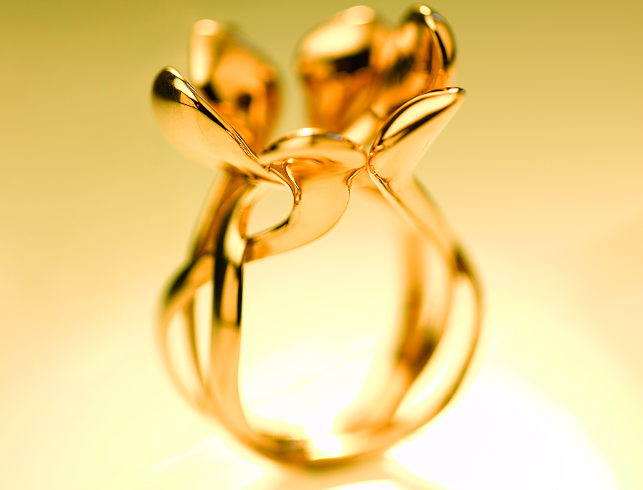
Cusing curves
This beautifully delicate organic-shaped ring was created by Italian jewellery designer Beatriz Biagi and forms part of her research into designing for manufacture with precious metals 3D printing.
An international jewellery design and product development specialist, Biagi has collaborated with a renowned companies and organisations, including the World Gold Council, Design Group Italia and Degussa. She teaches at the European Institute of Design (IED) in Turin.
The application of new technologies is one of the key elements of her work. Here, she’s partnered with Concept Laser, using its LaserCusing technology to take her design from CAD straight through to end product. Materialise Magics was used to build the supports.
LaserCusing allows designers the flexibility to produce intricate parts that would be too difficult, if not impossible, to manufacture using casting.
“This technology is already being used for production of non-precious objects and has given the opportunity to improve functional and aesthetical qualities of products,” says Biagi.
“Now, it is possible to create gold, silver and steel products taking advantage of direct manufacturing,” she adds.
Concept Laser and its UK agents ES Technology are specifically targeting the jewellery market with its smallest machine, the Mlab.
Of significant interest to smaller jewellery manufacturers is the system’s ability to reduce the size of the build and dose chambers up to 70% by volume. This means that a wider range of high-value materials can be utilised, bringing metals 3D printing within the reach of many more jewellery firms.

Heart of gold
As part of the Birmingham School of Jewellery’s 125th anniversary, the Precious Project aimed to develop commercially viable processes for manufacture using direct metal sintering.
The 18ct gold Heartbeat pendant designed by Lionel T Dean featured in the Precious Project exhibition.
It started life as a sheet metal heart that the client personalised with a hammer, before it was 3D scanned.
To reduce the amount of material needed, internal and external supports were then created in Delcam Part Builder.
The final piece was printed on a Precious M080 3D printer, before the surface was expertly finished.
The process has opened up a new world of shapes and forms to imaginative jewellery designers, by allowing hollow items to be rigidly supported inside, ensuring minimal waste.

Precious time
This watchcase was produced in a collaboration between precious metals 3D printing experts Cooksongold and London watchmakers Hoptroff.
Machining a watchcase is a high-precision blend of tolerances and dimensions – a beautiful tooldriven craft, but a wasteful one.
Given that the customers of highend timepieces like a bit of bling, CNC machining cases can create some very expensive waste.
Present-day 3D printing for lostwax casting is a limited option, dogged by fragility and shrinkage.
However, printing metal directly offers great capabilities.
Building the case from the end material allows the manufacturer to produce a near-net-shape watchcase that can be precision-machined for finish and functionality.
Built on Cooksongold’s Precious M080 SLS 3D printer in 10 hours, the 18ct gold case for Hoptroff required just 30 minutes of post-processing and produced only one gram of waste material.
How the jewellery designers and producers are adopting direct metals technology
Default






